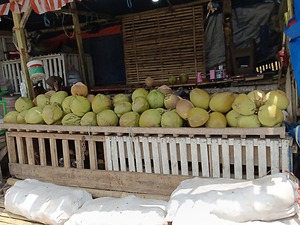


Husk Coconuts
Estimated Inventory, 20 ct : 0
Description/Taste
Husk coconuts are coconuts with their protective green husk, or exocarp, still intact. This exocarp is bright green with faint lines running from the top to the bottom of the coconuts. The fruit has a circular to elliptical shape, which tends to be rounded at the top and pointed at the bottom. There are lighter patches of yellow-green in parts of the smooth, firm exocarp and occasional dark brown bruising and scratching. Husk coconuts range in size depending on the variety but tend to measure about 30 to 45 centimeters long, 15 to 20 centimeters wide, and weigh approximately 1 to 2 kilograms each. Beneath the green layer is a brown, fibrous, furry husk called the mesocarp. When removed from the outer green layer, mesocarps are revealed to have a pointy fibrous tip and a wood-like texture that’s rough to the touch. The core of a coconut holds its meat, a 2.5-centimeter-thick layer of white, edible flesh with a firm, peelable texture that can be dry, chewy, and lightly crunchy. The hollow center of the coconut is filled with a milky-white liquid known as coconut water. Husk coconuts are not eaten in their entirety, as the edible parts are the flesh and milk. The flesh is gelatinous and creamy, with a sweet, nutty, and slightly woody flavor accented by tropical notes. The milk offers a refreshing, sweet liquid taste.
Seasons/Availability
Husk coconuts are available year-round.
Current Facts
Husk coconuts are botanically known as Cocos nucifera and belong to the Arecaceae family. The term husk is a general descriptor for any type of coconut with its exocarp intact, which is how coconuts naturally grow in the wild. Many coconut varieties are sold under this descriptor in markets. Coconut trees are a type of palm tree that comes in multiple varieties, including Panama Tall, Macapuno, Jamaican Tall, Chowgat, and King coconuts. These trees grow anywhere from about 13.5 to 15 meters tall. The wood from these trees is often used for timber, furniture, instruments, brooms, charcoal, baskets, and thatching. The husk from these coconuts is often repurposed into doormats, brushes, twine, and biodegradable packaging. The oil extracted from coconut meat is suitable for both cooking and non-culinary uses, such as skincare, haircare, perfumes, and other cosmetics. The husk of coconuts typically remains unused in culinary applications.
Nutritional Value
The nutritional value of Husk coconuts is derived from their meat and water. They contain iron, a nutrient that helps with energy and hormone production, immune and cognitive function, and cell growth. Coconuts also provide the body with manganese, assisting with bone health, metabolism support, wound healing, blood sugar regulation, and thyroid function. They are also a source of copper, a mineral that promotes red blood cell and tissue formation, iron metabolism, nerve transmission, and melanin production to protect from UV ray sun damage. Coconuts have magnesium in them, encouraging bone, heart, and digestive health as well as reducing inflammation. The oil made from their meat may be used topically to treat sores, cuts, and open wounds.
Applications
The husk of coconuts is rarely consumed, but the milk and meat, or flesh, from these fruits can be used in a variety of recipes. It may be consumed raw, shredded, toasted, cooked, puréed, baked, or converted into coconut oil or milk. Coconuts are often incorporated into desserts like cookies, macaroons, cakes, breads, seven-layer bars, bonbons, pies, custards, and puddings. In savory preparations, coconut meat is chopped up and mixed into curries, soups, vegetable bakes, and rice dishes. Shredded coconut is frequently employed as a breading for fried chicken and shrimp or sprinkled on top of cakes, acai bowls, yogurt parfaits, and granola. Coconut water can be incorporated into smoothies, cocktails, green juices, and liquors. Coconut pairs well with lime, lemon, salmon, broccoli, spinach, sweet potatoes, pumpkin, carrots, potatoes, jasmine rice, chia seeds, avocados, popcorn, and cream cheese. Husked coconut can be stored at room temperature for about four months.
Ethnic/Cultural Info
Coconut trees are one of the most important resources in the Samoan Islands. Coconuts are used in palusamiand fa’alifu taro, a traditional dish that mixes cream made from the meat of the fruit with taro leaves. In this dish, these fresh taro leaves are layered and filled with coconut cream, onions, and meat, then wrapped in small bundles and cooked in an umu, or traditional earth oven. In Samoa, coconut water is drunk for its hydrating capabilities and is frequently brought on fishing trips. They also hollow out the shells of Husk coconuts to use as utensils and containers for dye and employ the fibers from the husks for creating houses and canoes. These fibers may also be used as a strainer for kava, a popular drink in Samoa made from dried Yaqona plant roots.
Geography/History
Husk coconuts are native to Southeast Asia and flourish in tropical and subtropical climates. They grow wild throughout their native region, as well as in India, Sri Lanka, the Pacific Islands, Central and South America, the Caribbean, and coastal Africa. They are also cultivated commercially and in tropical gardens throughout the world. Much of the worldwide spread of coconuts can be attributed to the fruit drifting through ocean currents, as well as by migrating Polynesians and Indonesians. The Philippines, India, Mexico, Indonesia, Papua New Guinea, Malaysia, and Sri Lanka are now the main growing and exporting countries of Husk coconuts. This popular fruit can be found in major grocery stores, farmers’ markets, and specialty stores, particularly those with an emphasis on tropical produce.

















